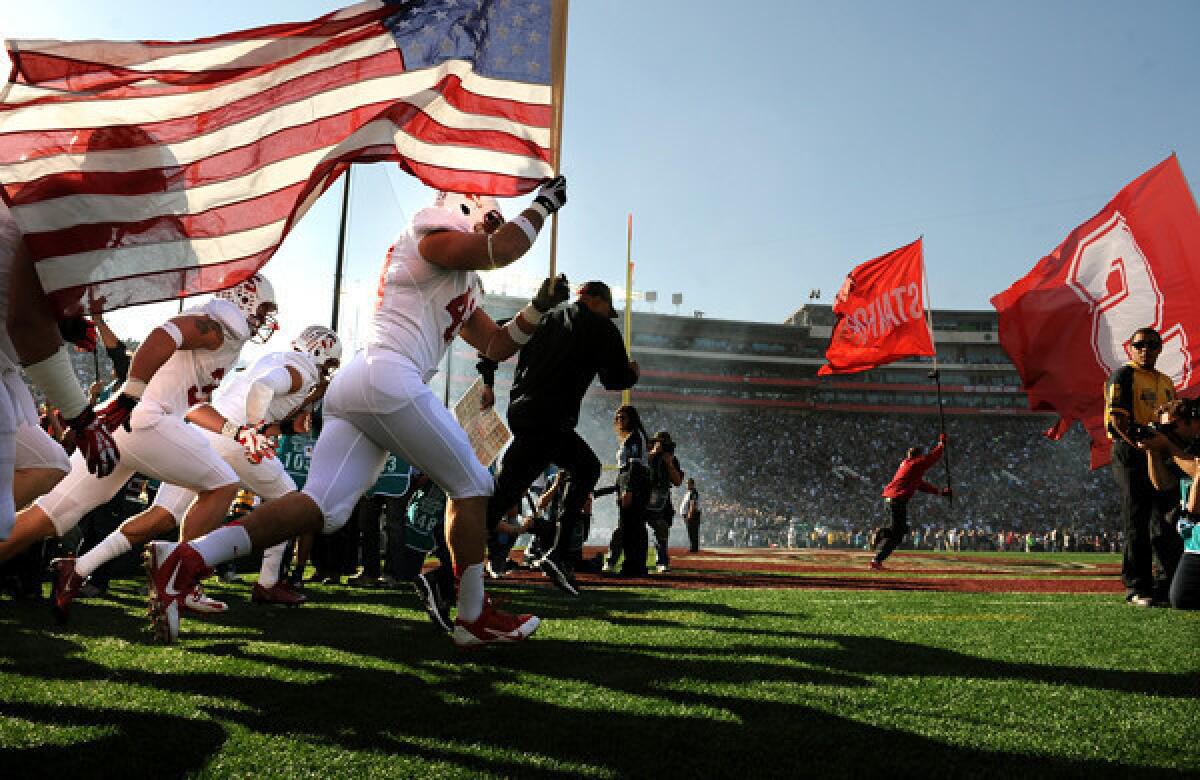Rose Bowl’s grass act: A new field in time for BCS title game

- Share via
What you probably didn’t know about Monday’s Bowl Championship Series championship is that it will be played on an entirely fresh field, placed directly atop the one you saw Wednesday at the Rose Bowl. Like a blanket over another blanket.
Senseless, right?
By all accounts, that Rose Bowl field was still nearly flawless after Wednesday’s game, but that didn’t stop groundskeepers. Foolish perfectionism is a Pasadena birthright and one I don’t condone. Yet that’s exactly what is behind this all-new grass, which requires a Herculean effort on a frazzled five-day time frame.
Sure, they have modified forklifts that unspool the sod in giant swatches. But in the end, laying a new field requires nearly 75 groundskeepers to push the puzzle together, starting work as soon as the Rose Bowl ends, blowing away the confetti, marking the sprinkler heads, then as midnight approaches — then passes, then sunup comes — laying down this magic carpet, by many estimates the finest playing field in the country.
Add six pockets and you’ve got yourself a very nice pool table.
As is my nature, I pitched in on this transformation. It really began a month ago. Soon as the last UCLA game ended Nov. 23, I joined Rose Bowl groundskeepers as they scraped out the old field and began to put in a new one.
I was there from the beginning, digging out clumps of old sod, thick and stubborn, like thatches of Einstein’s hair. Wouldn’t budge, most of it, till you got your mitts into it good — clawing, pulling and twisting.
When that didn’t work, I’d attack the stubborn turf with a shovel, chased with a couple of Tylenol.
A shovel, by the way, is this giant spoon you use to move dirt and sand. Many of you have never touched one. More of you prefer not to.
But I did. Just to take you inside the ultimate L.A. makeover. A blanket over another blanket. A Rembrandt over a Vermeer.
::
For the past dozen years, the Rose Bowl’s Marquis de Sod has been Will Schnell, a former schoolboy football star with a Hans Christian Andersen face, by way of Missouri. Each season, he passes along his country-boy skills to a cast of groundskeepers worthy of a Broadway comedy.
There’s George, a mechanical genius who invented the stadium’s fold-down uprights. Kyle, who grew up with Schnell and flies in every fall to help his old buddy prep the field. Neal, another accomplished field general, who came in from the Cleveland Browns soon as the season ended.
There are many more: Phil, Bobby, Edgar, Chris. Most essential are Miguel Yepez and Martin Rodriguez, the only full-timers in the bunch, who understand all the technical stuff, ranging from the 36 embedded moisture sensors to the nutrition reports Schnell receives from a New York lab each week.
Schnell calls them “tissue samples,” blades of Bermuda and winter rye he sends to the lab. In return, he gets a full report on whether the nutrients in the soil — nitrogen, phosphorous, potassium, calcium — are making their way up into the grass.
Anyone who’s been around Schnell for any length of time has a story to tell about seeing him belly down on the field, measuring to see if it needs mowing, or counting new shoots of winter rye to be sure it’s germinating.
Like lashes on a starlet, the Rose Bowl can never have too much heavy growth. One of the first things teams do when they see the field is to kneel down to tousle it as you would a child’s hair, to run their fingers across its sable surface, to check to see if it’s made by God or Monsanto.
You have to touch it to be sure.
::
My role is simple: to carry this band of experts to the next level, using a rake and muscles dormant since the Reagan administration.
The Rose Bowl turf is mostly Bermuda, grown near Palm Springs, three fields of the stuff — one for the Rose Bowl, one for the BCS, a third as a spare, in case something goes wrong with the other two.
The field you’ll see Monday night was cut by West Coast Turf the same day it was laid (Wednesday), rolled like hay, then transported by semis to the Seco exit off the 210, where it waited for the Rose Bowl to end, then arrived about 8 p.m. at the tunnel near the Stanford locker room. Because there are only five days between games, the old turf is not removed; the new grass plops right on top.
You’re wondering, probably, how it will stay put for the BCS game, since it’s sod atop sod, and there’s no way it can root. The simple answer: sheer heft. The rolls are 50 feet long, three feet wide and a brick-like three inches thick.
They weigh more than your Kenmore and nothing — not a fullback’s karate kick or a tuba player’s stutter step — could ever unseat it.
The key for the grounds crew is to get the seams jigsaw tight, so the whole quilt becomes one.
For the Rose Bowl game, we laid the slabs sideline to sideline, filled the gaps with green sand, watered it, mowed, fertilized, painted the end zones using giant plastic tarps as stencils. Unique to the Rose Bowl, participating teams select the exact shade from color strips applied to sample swatches of sod.
Five days after sodding for the Rose Bowl game, Schnell is happy with the look of the field, which gives him confidence they can get things right with the same five-day window he has to work with before the BCS.
By the time the 100th Rose Bowl is over, 702 total yards not including marching bands, TV crews and a postgame mob, the field is still nearly flawless — a divot here, a pimple there.
Then it begins all over again.
Schnell, 51, says he picked his profession because it blended the two things he liked best: farming and football. In the Missouri state final in 1981, Schnell, an undersized offensive lineman for the Marshall Owls, is remembered for running down the other team’s fastest player from behind.
So, more than most, he understands what it would mean Monday if a receiver stumbled over a sprinkler head or a lip of sod at a pivotal moment.
There are 102 sprinkler heads in the Rose Bowl. There are almost countless lips of sod.
::
If I can do this, you could do this.
I’ve got a rake, and when someone yells “Push!” I shove the rake into the edge of the sod, so that the big green ribbon slides exactly into place, snug as a dog against your thigh.
The first row Wednesday night, right down the middle of the field, again running from sideline to sideline, takes a while to get right. Think of it as laying a ship’s keel. Mess it up, and you’ve got a Titanic.
Behind us, leaf blowers make a pass, shooing out the excess sand. Then Kyle Naylor, Schnell’s childhood buddy, follows up with a watering hose, hydrating the sod as soon as possible, spritzing it awake again.
It’s not complicated work, but there’s a heave-ho quality to it, a sense of teamwork, everyone rowing in the same direction.
“You’ve got to get a rhythm,” one of Schnell’s supervisors yells to his crew. “It’s like a dance.”
Yeah, a very big dance, on what Monday will be college football’s greatest stage.
Still think this new sod is senseless? Not hardly.
twitter.com/erskinetimes
More to Read
Go beyond the scoreboard
Get the latest on L.A.'s teams in the daily Sports Report newsletter.
You may occasionally receive promotional content from the Los Angeles Times.











